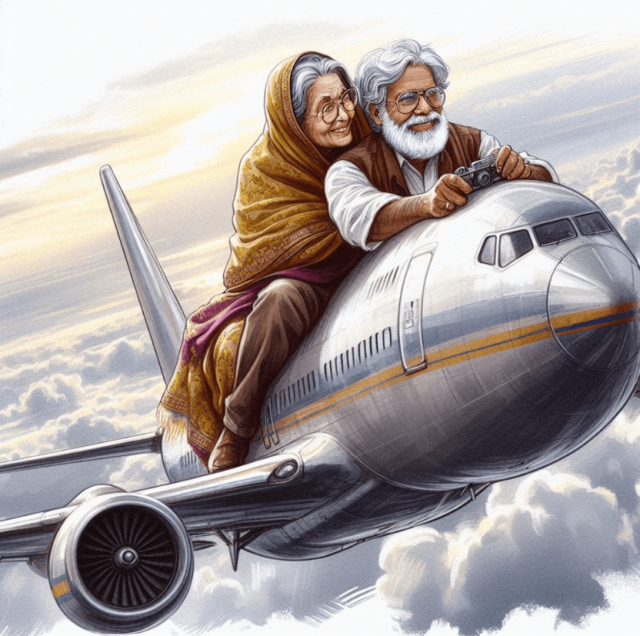Traveling is a great way to explore new places, meet new people, and enjoy life. However, for seniors, flying long haul can pose some health risks and challenges, especially in the post-Covid era. Therefore, it is important to plan and take some precautions to ensure a safe and comfortable journey. Here are some tips to help you fly long haul as a senior.
- Choose Your Flight Wisely
When booking your flight, consider the following factors:
- Layover duration: If you must change flights, make sure you have enough time to rest and transfer between terminals. Ideally, you should have at least 2-3 hours of layover time. This way, you can avoid stress and rush in case of any delays or cancellations.
- Departure time: Try to avoid flights that depart between 2 AM and 6 AM. These flights can disrupt your normal sleep cycle and cause fatigue, jet lag, and lower immunity. Instead, opt for flights that depart in the morning or afternoon, so that you can get some sleep before or during the flight.
- Price: While price is an important factor, it should not be the only one. Sometimes, cheaper flights may have longer travel time, more layovers, or less amenities. These can affect your comfort and health during the flight. Therefore, compare different options and choose the one that suits your budget and needs.
- Select Your Seat Carefully
Your seat can make a big difference in your flying experience. For seniors, the best seats are:
- Aisle seats: These seats allow you to get up and move around more easily, without disturbing other passengers. This can help you prevent stiffness, swelling, and blood clots in your legs, which are common problems for seniors on long flights.
- Center cluster seats: These seats are located in the middle section of the plane, where there are usually four seats in a row. If you choose an aisle seat in this section, you will only have one neighbour to your side, unlike the window section, where you will have two. This can reduce the chances of being disturbed or interrupted by other passengers.
- Seats near the bathrooms: These seats are convenient for seniors who need to use the restroom frequently. They can also help you stay hydrated, as you can drink more water without worrying about the hassle of going to the bathroom. However, be aware that these seats may also be noisy and smelly, so weigh the pros and cons before choosing them.
- Dress Appropriately
The temperature and humidity inside the plane can vary greatly, depending on the outside weather, the air conditioning, and the altitude. Therefore, you should dress appropriately to cope with these changes. Here are some tips:
- Wear layers: Layering your clothes can help you adjust to different temperatures and climates. You can add or remove layers as needed, depending on how you feel. For example, you can wear a t-shirt, a sweater, and a jacket, and take off or put on the outer layers as required.
- Wear loose and comfortable clothes: Tight and restrictive clothes can hamper your blood circulation and cause discomfort. Loose and comfortable clothes can help you breathe better and relax more. They can also prevent chafing and irritation on your skin.
- Wear pockets or a cross-body/waist bag: These can help you keep your essential documents, such as your passport, tickets, and boarding passes, handy and secure. You can also store some cash, credit cards, and medications in them. This way, you can avoid losing or misplacing your important items during the flight.
- Wear slip-on shoes and socks: Slip-on shoes can help you pass through the security check faster and easier. They can also help you take off and put on your shoes more conveniently during the flight. Socks can keep your feet warm and prevent them from swelling. You can also wear compression socks, which can improve your blood flow and reduce the risk of deep vein thrombosis (DVT).
- Pack Light and Smart
Packing light and smart can help you avoid unnecessary stress and hassle during your flight. Here are some tips:
- Limit your hand baggage: Most airlines allow you to carry up to 7 kg of hand baggage, but you should try to keep it less than 3 kg. Carrying heavy hand baggage can strain your back, shoulders, and arms, and make it harder for you to move around. It can also take up more space in the overhead bins or under the seat, leaving less room for your legs.
- Use four-wheeled check-in baggage: Four-wheeled check-in baggage can help you manoeuvre your luggage more easily and smoothly, without putting much pressure on your wrists and arms. They can also stand upright on their own, so you don’t have to bend down or lean over to hold them.
- Weigh your baggage before leaving for the airport: This can help you avoid paying extra fees for overweight baggage, or having to repack or discard some items at the airport. You can use a digital luggage scale or a bathroom scale to measure your baggage weight at home. Make sure you check the baggage allowance and restrictions of your airline and destination before packing.
- Choose stackable hand luggage: Stackable hand luggage can help you save space and effort when transporting your luggage. You can place your hand luggage on top of your check-in baggage and roll them together, instead of carrying them separately. This can also reduce the chances of losing or forgetting your hand luggage.
- Hand/Cabin Baggage Checklist: Here are some items that you should pack in your hand/cabin baggage:
- Essential medicines (no liquid bottles more than 100 ml) and prescriptions for prescription medicines
- Some high-energy snack items, such as trail mix, protein bars, nuts, dried fruits, etc.
- Extra layer of clothing, head scarf, and woolen cap, in case you are going from a warm climate to a cold climate, or vice versa
- Compression socks, eye mask, ear plugs, neck pillow, mobile charger, and other items that can enhance your comfort and sleep quality during the flight
- Travel toilet kit, containing small bottles of essential items, such as toothbrush, toothpaste, deodorant, moisturizer, sanitizer, wipes, etc.
- One extra pair of clothes and sleepwear, in case your baggage gets delayed or lost, or you need to change your clothes due to spills, stains, or accidents
- Follow Some General Tips
Here are some general tips that can help you fly long haul as a senior:
- Request a wheelchair if needed: If you have difficulty walking or standing for long periods, you can request a wheelchair at the time of booking your ticket. The airline staff will assist you with boarding, deboarding, and transferring between flights. You can also use a cane, walker, or crutches, if you prefer.
- Request a meet and greet service if needed: If you need assistance with check-in, immigration, and security, due to language or any other issue, you can request a meet and greet service from the airport. They can provide you with a personal escort who can guide you through the airport procedures and help you with your luggage and documents. They can also arrange for special facilities, such as priority boarding, lounge access, or special meals, if required.
- Stay hydrated and eat healthy: Flying long haul can dehydrate you and affect your digestion. Therefore, you should drink plenty of water and avoid alcohol, caffeine, and carbonated drinks, which can dehydrate you further and cause bloating and gas. You should also eat light and healthy meals, and avoid spicy, greasy, or sugary foods, which can upset your stomach and cause nausea or indigestion.
- Move around and stretch: Sitting for long hours can cause stiffness, soreness, and cramps in your muscles and joints. It can also increase the risk of DVT, which is a serious condition where a blood clot forms in your leg and travels to your lungs, causing a pulmonary embolism. Therefore, you should move around and stretch every hour or so, to improve your blood circulation and flexibility. You can walk up and down the aisle, do some simple exercises in your seat, or use the in-flight entertainment system to follow some yoga or aerobics videos.
- Enjoy the flight and have fun: Flying long haul can be a great opportunity to relax, have fun, and learn new things. You can use the in-flight entertainment system to watch movies, listen to music, play games, or read books. You can also chat with your fellow passengers, make new friends, or share your stories and experiences. You can also use the flight time to plan your itinerary, research your destination, or learn some basic phrases in the local language. The most important thing is to enjoy the flight and have a positive attitude.




